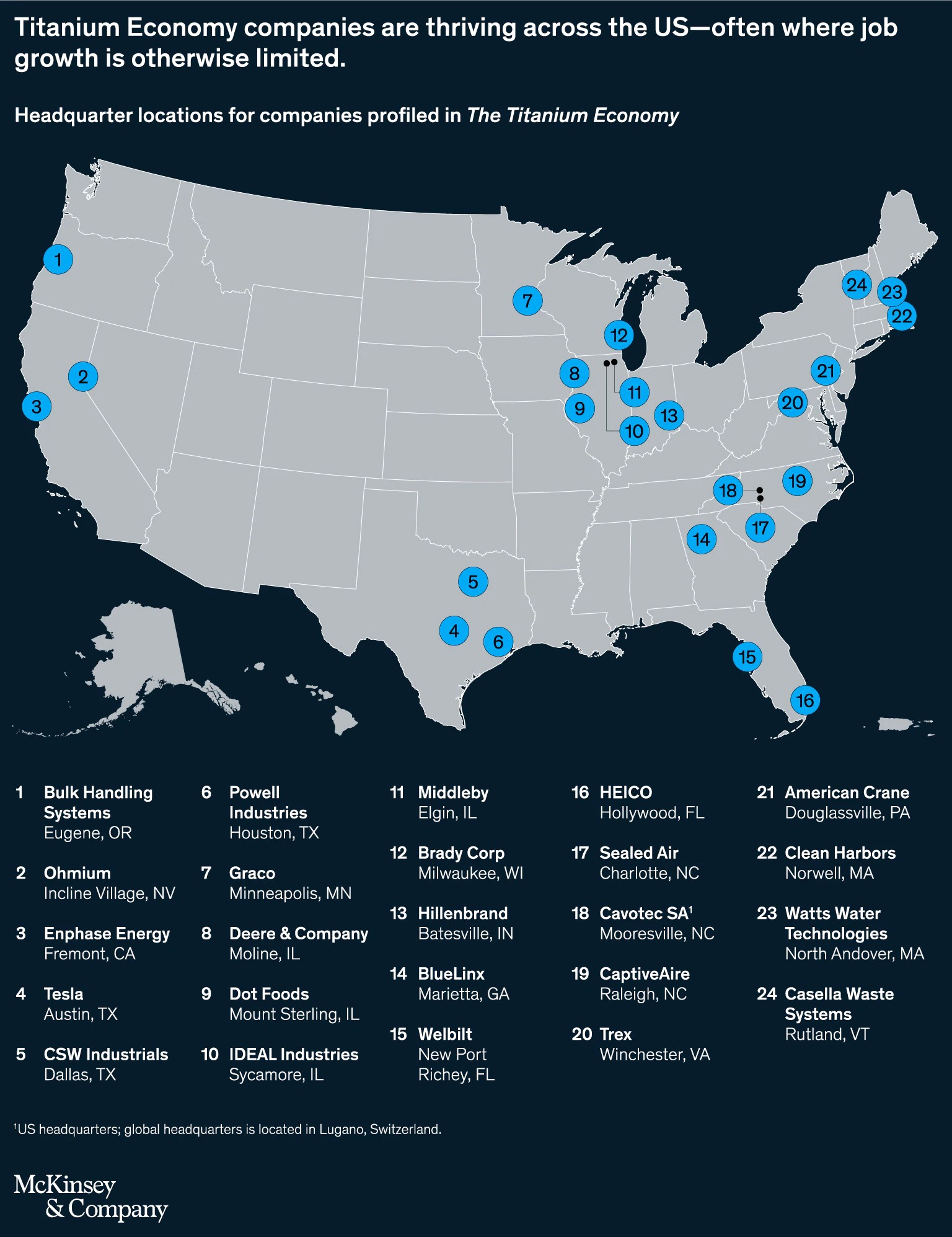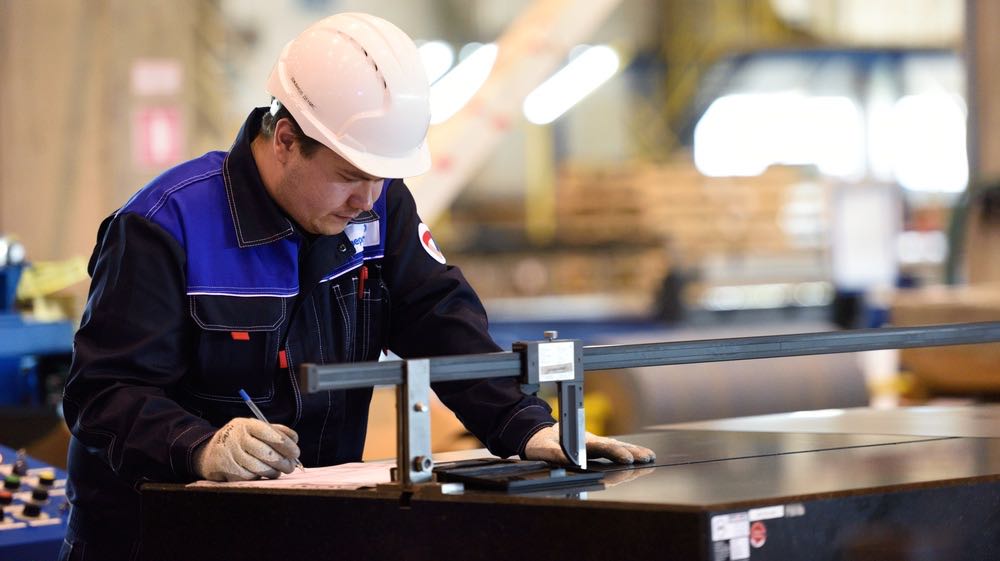5 myths—and an inspiring truth—about U.S. manufacturing

- In their book THE TITANIUM ECONOMY: How Industrial Technology Can Create a Better, Faster, Stronger America, David Ebenstein and Asutosh Padhi explore the current state and future of industrial technology in the U.S.
- The “Titanium Economy” refers to a modern, reinvented industrial sector that incorporates the latest technology into manufacturing processes to produce things upon which we all rely.
- Strengthening this sector, Ebenstein and Asutosh argue, would make the U.S. more globally competitive while also creating more dependable, high-paying jobs for Americans.
The words “American manufacturing” might bring to mind a landscape of abandoned mills and crumbling factories. But that’s largely an image from the last century. Today, thousands of advanced industrial technology companies are humming across the United States. These members of the “Titanium Economy” are making essential products in safe, spotless workplaces and, not incidentally, delivering excellent financial returns.
The Titanium Economy matters. These companies provide millions of rewarding, well-paid jobs, many of which don’t require college degrees. The firms are pillars of their communities. And they make the U.S. more competitive and economically resilient in the volatile global marketplace.
But understanding the value and the promise of the Titanium Economy requires getting past the many myths still associated with US manufacturing.
Here are five of them.
Myth #1: Manufacturing is dying
American manufacturing is strong across many measures: across the 22 manufacturing categories defined by the United Nations, the country is in first or second place in 19. Industrial employment is rising, growing from 11.6 million in January 2011 to 12.5 million in October 2021. Manufacturing provides at least 20 percent of employment in 460 U.S. counties, many of them in rural and suburban areas, and they can be critical in creating broad-based prosperity.
Take Simpsonville, South Carolina, which is the heart of an industrial technology hub known as the “Golden Strip.” It’s just one powerful example of how manufacturing can breathe life into once-struggling areas.
Simpsonville’s transformation began when Michelin opened its North American headquarters there in the mid-1980s, not long after the local textile industry had all but shut down. Impressed by the business-friendly climate and the many skilled, hard-working people who lived there, Bridgestone and BMW followed. Before long, other new factories were cranking out not just high-end tires and cars but wide-body airplanes, medical devices, and advanced materials. Median annual household income in Simpsonville now tops $75,000—25 percent higher than the state average. Public schools are above average, quality of life is good, and there are a wide range of rewarding jobs available.
Myth #2: It’s dirty and boring
Walk into an American factory today, and you’re likely to see a quiet, gleaming bastion of efficiency and innovation. Employees enjoy superior working conditions, from the factory floor to design and engineering studios. Every day, more industrial-tech firms bring smart technology into their manufacturing processes and their products.
Brady Corporation, for example, is a leading provider of industrial labels, safety devices, and printing systems. In the company’s sleek, high-tech factory in Eau Claire, Wisconsin, it can control quality and create advanced software interfaces for customers that raise user experience to a new level.
Myth #3: It’s not profitable
In researching the Titanium Economy, we found that many of these companies, about 4,500 of them private and 700 public, have kept pace with – and in some cases, outperformed – the Silicon Valley tech giants many people now equate with exemplary business performance. Members of the Titanium Economy represent 380 of the top 1,000 private companies ranked by revenue across sectors. Overall, their revenues grew 4.2 percent per year from 2013 to 2018—1.3 percentage points faster than the S&P 500.
HEICO, an aerospace industrial defense and electronics company based in Florida, is a prime example. The company has grown total shareholder returns by 47,500 percent since 1990. In the past decade alone, the value of its shares has risen by 1,270 percent compared to the S&P 500’s 250 percent. There are profits to be made across the industrial technology sector.
Myth #4: The future is only services and tech
It’s not an either/or proposition: services and technology matter, of course, but so do companies that make things. Manufacturers and suppliers that accelerate their adoption of technology and digital innovations could create as much as $3.7 trillion in value by 2025.
The pandemic and geopolitical tensions are reminders of the value of domestic manufacturing. That is why many companies are building more resilient supply chains; the country is on track to add over 350,000 jobs in 2022, up from 220,000 in 2021 and 160,000 in 2020.
Myth #5: Automation will be the death of manufacturing jobs
Forecasts show that the talent gap in the United States could grow to more than six million workers by 2030, costing the country a projected $1.7 trillion in GDP. The industrial sector is not immune to this trend. In just the last decade, 2.4 million industrial jobs alone have gone unfilled; right now, the figure is about half a million. That is a loss of economic output—and opportunity—that the country can ill afford.
Automation won’t kill manufacturing jobs so much as change them—it is up to industrial companies and the communities where they operate to help workforces keep pace with technological change. Graco, a Minneapolis-based fluid-handling manufacturer, is showing the way. The company needs technically skilled people, so it has built relationships with local trade schools, offering scholarships, capital equipment, and apprenticeships. These kinds of investments pay healthy returns—and will be necessary to fulfill the promise of U.S. manufacturing.

Manufacturing is a key to a healthy and diversified economy that serves all Americans. Companies in the sector are consistently underappreciated—less than one percent of venture capital is invested in industrial technology—and government support is limited, especially compared to what some other countries provide.
Advancing the Titanium Economy should be a national priority, with a clear strategy. We must widen and deepen the manufacturing talent pool, for example by bringing more women into the trades, expanding career and trade school programs, and offering more apprenticeships and alternative credentialing.
Perhaps most importantly, we must smash myths and change mindsets to inspire the next generation to consider careers in manufacturing. I’ve seen the benefits of the Titanium Economy in communities across the country; it’s striking how many of them look like great places to live, with lively downtowns and oodles of civic pride.
That’s inspiring—and it’s built on the promise, and reality, of American manufacturing.




